Post Doctoral Research Associate
Princeton University, Astrophysical Sciences

After taking an astronomy class my sophmore year of college, it took me several years to decide to return to school (while working full time) and pursue a career in physics and astronomy. My main enjoyment comes from solving difficult problems, regardless of which area of math or science the problem is in. In fact, I often enjoy working on problems in new subfields that require me to research and learn about new areas of science and mathematics. This has resulted in many changes in my active field of research, from an optics lab as an undergraduate, to both experimental and theoretical high energy physics in graduate school, the finally settling down in observational astronomy for my PhD research. My current research involves working on a deblender for the LSST, which separates the flux from overlapping "blends" of stars and galaxies to estimate the "true" flux from each object.
Princeton University, Astrophysical Sciences
University of Rochester, Physics and Astronomy
enerSave, Wireless Lighting Solutions
Broadpoint Inc, Cellular and Satellite Communications
Ph.D in Physics and Astronomy
University of Rochester
M.A. in Physics and Astronomy
University of Rochester
Bachelor of Science in Physics
University of New Orleans







Most of my research time is dedicated to working on the deblender for the Large Synoptic Sky Telescope. Peter Melchior and myself have been implementing a new algorithm that extends the well known (in computer science) ADMM algorithm to model each source in the blend as an SED multiplied by an intensity profile to to match the data. Our preliminary results show show significant improvement over other deblenders and an algorithmic paper is soon to be published.
In my remaining time I am continuing my PhD project to search for low mass stars and brown dwarfs in the UCL and LCC subgroups of Scorpius-Centaurus, the nearest OB associtation to the sun. My PhD produced a candidate list of several hundred prospective members selected using DECam photometry and we are currently using the new ARCoIRIS spectrograph to follow up on the candidates and confirm their spectral type and youth. Completing this survey will give the largest population of 10-20 Myr substellar objects, an important constraint on our understanding of star and planet formation.
As a byproduct of my various research projects, I have a number of software packages designed to assist researchers in viewing and interacting with large datasets. These include packages to run large data pipelines, including one designed specifically for observational astronomy, and two different visualizations packages (one of which is under current development).
I have also been a freshman physics instructor at Princeton University and both a head TA and undergraduate instructor in physics at the University of Rochester. With the help of Dan Watson I instituted a "flipped classroom" (also called the Keller Plan, Mastery, or Self-Paced Learning) to combat problems encountered in physics education for non-majors. My class was so successful that the physics department changed the structure of its undergraduate curriculum to implement a self-paced course very similar to the one I taught over the summer.
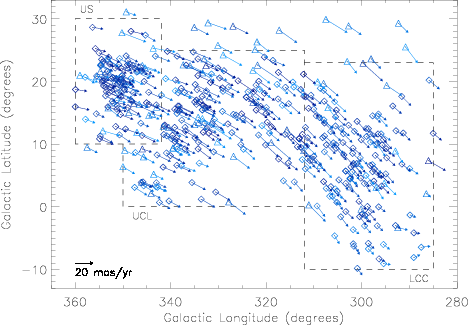
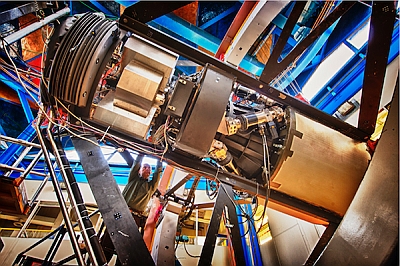
The vast size and quantity of images genearated by a single DECam run is much larger than the volume of data astronomers are used to processing. While NOAO has a community pipeline that processes images before they are distributed to the observer it lacks any guidance or tools for post pipeline processing. We created an astronomy pipeline package that other observers can use to perform common tasks such as source detection, photometry (and calibration to the SDSS and UKIDSS standards), improved astrometry, approxiamte spectral classification based on the available photometry, and customization of the pipeline that performs all of these tasks. Github Repository
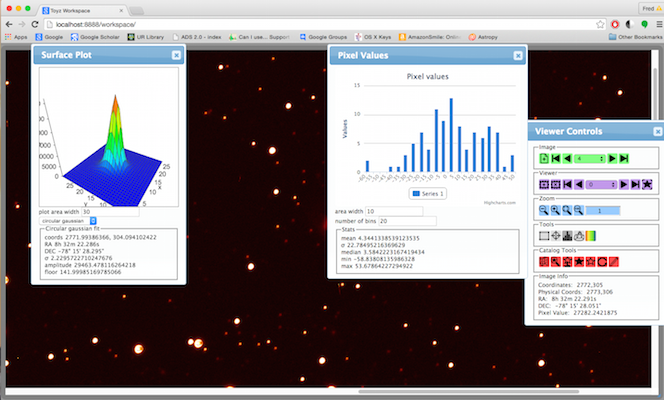
The large size of DECam images (~10kx10k and over 2Gb) required a new set of tools to view those images in a "slippery map" or Google maps style application. Toyz was created to fill that need by running a web application on a remote server while a client that runs in a browser is used to browse the server, view and interact with images on the server, and create interactive plots of linked data stored on the server. Github Repository
(a new soon to be released package extends the Toyz functionality to Jupyter notebooks, integrating it into a more established platform)
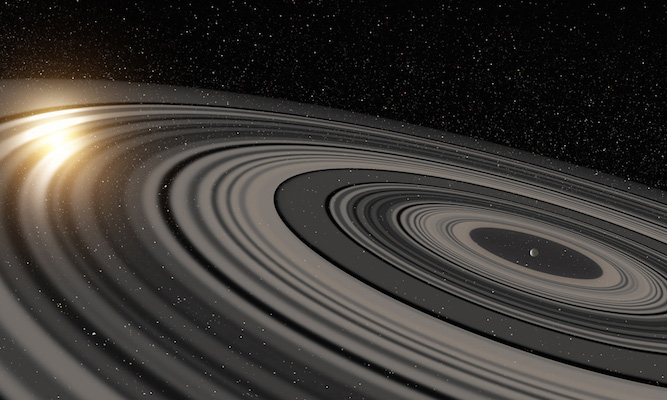
In 2010 our group discovered the first light curve that appears to be a low mass star or planet with a large ring system orbiting another star. I wrote a large part of the code that created theoretical models of eclipsing ring systems that we used to demonstrate the likelyhood that the observed object is indeed a star or planet with a ring system eclipsing its parent.

Students entering STEM fields or taking required STEM classes have a large variety of skills and prior knowledge that makes it difficult to instruct them in a one size fits all class that moves at the same pace for everyone. With the help of Dan Watson I developed a self-paced freshman physics class for non-majors that provided students with video lectures and used Tom Moore's Six Ideas that Shaped Physics.
The class was a huge success with my class performing significantly better on a common exam taken by a traditional lecture class. The class was so successful that the University of Rochester added a self-paced section of physics for engineers during the semester and made it the recommended section.

This package provides a set of classes to assist python developers in debugging their codes. In addition to adding breakpoints to a code, a decorator allows developers to wrap functions that will open an ipython console everytime the function is called, or the first N times a function is called, making it easier to debug recursive function calls. Github Repository
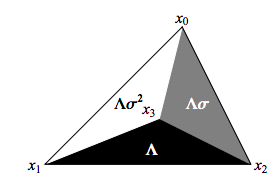
The experimental discovery of the Higgs boson and the apparent absence of super symmetry has renewed interest in understanding and improving scalar quantum field theories.
For two years of graduate school I worked in a theoretical physics group and one of our projects was the development of a scalar quantum field using the Finite Element Method. Our research was based on the idea that space-time might appear to be cartesian but at small scales may have a better description as a fractal space with dimension close to 4.

The question of which quantum systems are chaotic and even what it means for a quantum system to be chaotic is still an open question. Our group attempted to gain insight into quantum chaos by studying systems that could (and could not) be chaotic. Our first attempt at this was to create a general solution to the Rabi Model, a simple to describe system of interest to researchers in quantum optics. Our goal was to understand what makes a system like the Rabi model solvable in order to theorize the form of a system that woud not be solvable, and thus chaotic.
The two "in prep" publications below are both in the final stages of collaborative editing and will both likely be submitted for publication by the end of the summer.
We conduct the first wide-field survey for very low mass stars and brown dwarfs in Scorpius-Centaurus (Sco-Cen), the nearest OB association to the solar system. Using images taken with the Dark Energy Camera (DECam), the first extensive survey of low mass and substellar objects is made in the 15-20 Myr Upper Centaurs Lupus (UCL) and Lower Centaurus Crus (LCC) subgroups of Sco-Cen. Due to the size of our dataset (>2Tb) we developed an extensive open source set of python libraries to reduce our images, including astrometry, stacking, and PSF photometry. Our survey consists of 29, 3 square degree fields in the UCL and LCC subgroups of Sco-Cen and the creation of a catalog with over 11 million point sources. We create a prioritized list of candidate for members in UCL and LCC, with 118 best and another 279 good candidates. We show that the luminosity and mass functions of our low mass and substellar candidates are consistent with measurements for the younger Upper Scorpius subgroup and estimates of a universal IMF, with spectral types ranging from M1 down to L1. Infrared excess measured using AllWISE colors suggests that the disk fraction of substellar objects at ~16 Myr increases with decreasing substellar mass, showing possible signs of planet formation around early M dwarfs.
We introduce a generalization of the Alternating Direction Method of Multipliers to optimize a real-valued function f of multiple variables with multiple constraints g_i on each variable. As long as f and all g_i are convex and can be represented by proximal operators, none of them have to be smooth. The new General Linearized Method of Multipliers (GLMM) can be interpreted as a proximal analog to inexact line search under constraints. It supersedes and is more generally applicable than Simultaneous Direction Method of Multipliers. GLMM is well-suited for a large range of optimization problems, in particular for data analysis, where f is the likelihood function of a parametric model. We apply GLMM to the Non-negative Matrix Factorization problem \red{and show that its convergence rates are superior to existing methods, including the popular Alternating Least-Squares method.
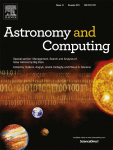
As the size of images and data products derived from astronomical data continues to increase, new tools are needed to visualize and interact with that data in a meaningful way. Motivated by our own astronomical images taken with the Dark Energy Camera (DECam) we present Toyz, an open source Python package for viewing and analyzing images and data stored on a remote server or cluster. Users connect to the Toyz web application via a web browser, making it an convenient tool for students to visualize and interact with astronomical data without having to install any software on their local machines. In addition it provides researchers with an easy-to-use tool that allows them to browse the files on a server and quickly view very large images (> 2 Gb) taken with DECam and other cameras with a large FOV and create their own visualization tools that can be added on as extensions to the default Toyz framework.
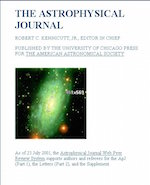
We investigate the nature of the unusual eclipsing star OGLE LMC-ECL-11893 (OGLE J05172127-6900558) in the Large Magellanic Cloud recently reported by Dong et al. The eclipse period for this star is 468 days, and the eclipses exhibit a minimum of ~1.4 mag, preceded by a plateau of ~0.8 mag. Spectra and optical/IR photometry are consistent with the eclipsed star being a lightly reddened B9III star of inferred age ~150 Myr and mass ~4 M ☉ . The disk appears to have an outer radius of ~0.2 AU with predicted temperatures of ~1100-1400 K. We model the eclipses as being due to either a transiting geometrically thin dust disk or gaseous accretion disk around a secondary object; the debris disk produces a better fit. We speculate on the origin of such a dense circumstellar dust disk structure orbiting a relatively old low-mass companion, and on the similarities of this system to the previously discovered EE Cep.
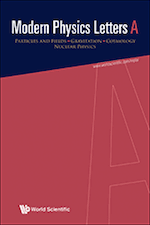
We study a model of scalar quantum field theory (QFT) in which spacetime is a discrete set of points obtained by repeatedly subdividing a triangle into three triangles at the centroid. By integrating out the field variable at the centroid we get a renormalized action on the original triangle. The exact renormalization map between the angles of the triangles is obtained as well. The map can be used to find the partition function in scalar field theories in a recursive manner. A fixed point of this map is the cotangent formula in Finite Element Method which is used to find the energy stored in fields on a plane due to a Laplacian.

The large relative sizes of circumstellar and circumplanetary disks imply that they might be seen in eclipse in stellar light curves. We estimate that a survey of ~10 4 young (~10 million year old) post-accretion pre-main-sequence stars monitored for ~10 years should yield at least a few deep eclipses from circumplanetary disks and disks surrounding low-mass companion stars. We present photometric and spectroscopic data for a pre-main-sequence K5 star (1SWASP J140747.93–394542.6 = ASAS J140748–3945.7), a newly discovered ~0.9 M ☉ member of the ~16 Myr old Upper Centaurus-Lupus subgroup of Sco-Cen at a kinematic distance of 128 ± 13 pc. This star exhibited a remarkably long, deep, and complex eclipse event centered on 2007 April 29 (as discovered in Super Wide Angle Search for Planets (SuperWASP) photometry, and with portions of the dimming confirmed by All Sky Automated Survey (ASAS) data). At least five multi-day dimming events of >0.5 mag are identified, with a >3.3 mag deep eclipse bracketed by two pairs of ~1 mag eclipses symmetrically occurring ±12 days and ±26 days before and after. Hence, significant dimming of the star was taking place on and off over at least a ~54 day period in 2007, and a strong >1 mag dimming event occurring over a ~12 day span. We place a firm lower limit on the period of 850 days (i.e., the orbital radius of the eclipser must be >1.7 AU and orbital velocity must be < 22 km s –1 ). The shape of the light curve is similar to the lopsided eclipses of the Be star EE Cep. We suspect that this new star is being eclipsed by a low-mass object orbited by a dense inner disk, further girded by at least three dusty rings of optical depths near unity. Between these rings are at least two annuli of near-zero optical depth (i.e., gaps), possibly cleared out by planets or moons, depending on the nature of the secondary. For possible periods in the range 2.33-200 yr, the estimated total ring mass is ~8-0.4 M Moon (if the rings have optical opacity similar to Saturn's rings), and the edge of the outermost detected ring has orbital radius ~0.4-0.09 AU. In the new era of time-domain astronomy opened by surveys like SuperWASP, ASAS, etc., and soon to be revolutionized by Large Synoptic Survey Telescope, discovering and characterizing eclipses by circumplanetary and circumsecondary disks will provide us with observational constraints on the conditions that spawn satellite systems around gas giant planets and planetary systems around stars.
There has been renewed theoretical interest recently in the Rabi model due to Braak's analytical solution and introduction of a new criterion for integrability. We focus not on the integrability of the system but rather why it is solvable in the first place. We show that the Rabi model is the limiting case of a more general finite dimensional system by use of a contraction and suggest that this is the reason for it's solvability, which still applies in the case of non-integrable but solvable variations.

We present experimental evidence of an enhanced magnetooptical response in chemically synthesized noble metal-magnetic oxide nanocomposites. Colloidal gold and magnetite (Fe3O4) nanoparticles were chemically linked using a bifunctional organic ligand creating clusters of the two nanoparticle components. The linked gold-magnetite clusters were blended with a transparent polymer and cast as films. Three samples were produced with a different ratios of 30-nm gold and 8-nm magnetite nanoparticles. The localized surface plasmon peak of the gold nanoparticles observed in the optical absorption data at 538 nm. Spectral Faraday rotation and ellipticity data show changes in both spectra which correlate to this surface plasmon resonance wavelength. Specifically, the inclusion of gold nanoparticles results in a change in sign of the Faraday rotation as well as an enhancement of the ellipticity of about 1.8 in the spectral region corresponding to the surface plasmon absorption peak of the gold nanoparticles. Standard models which ignore optical coupling between particles cannot account for the observed effects. The results suggest that the effects are caused by near-field coupling between the optical field concentrated near the gold nanoparticle surface and the magnetite nanoparticles.
While I love presenting and preparing lectures, I've found that non-traditional methods seem to reach more students and improve their performance on exams. My teaching philosophy is that we should be constantly re-examining our teaching methods and their effectiveness as the types of students and their preparation for college physics changes.
My experience as a head TA in classes with 200-300 students was that the majority of students were learning just enough physics to pass with a C average while not actually being able to solve any problems 100% correctly. To combat this Dan Watson assisted me in creating a self-paced physics class based on the Keller Plan used at UCSD when he was an undergraduate. We modernized the format by adding video lectures and Tom Moore's Six Ideas that Shaped Physics, a series of textbooks designed for a flipped classroom. The class was divided into 21 short "modules", each of which tested a specific topic in freshman mechanics (like energy conservation, or equations of motion). When a student felt sufficently prepared he/she was allowed to take a short 2 or 3 question test on the unit. If the student correctly answered all of the questions he/she was allowed to move on to the next unit. Students who missed any questions would have to review the unit and work more practice problems before taking a similar exam. Instead of the students grades being based on the % of questions they answered correctly, the students grades were based on the % of modules completed, and their score on a final exam (that was also given to a lecture based class for comparison). Using the curve from the lecture based class, all but one of my students earned a B or better. This method was so successful that the physics department adopted a similar model for their freshman physics for engineering majors. Another advantage of this type of class is that it provides a rich dataset of student performance that can be used to continually tailor the class to the needs of the most recent students.
I was also in charge of creating an online astronomy class with Adam Frank that ran on Coursera based on his book At Play in the Cosmos. The class included video lectures with images and animations from NASA and other public domain archives as well as animations and images I created to assist students in understanding topics like planetary structures, relativity, and Keplarian orbits. We also experimented with using interactive javascript tools to challenge the students to interact with the concepts involved in the class as opposed to merely plugging numbers into formulas. The course had over 30,000 students and taught us a lot about creating content that appeals to a braod audience.
In the future I plan to create an online course in observational astronomy to expose a larger number of students to the tricks and tools needed to do research in modern astronomy using Jupyter notebooks and real data from online publically available archives.
I am not currently teaching any classes
The freshman physics courses at Princeton are taught as a combination of a once a week lecture (taught by a faculty member), and a 3 times a week precept taught by a faculty member or post doc. I was one of 4 instructors for this course in the fall of 2016.
I assisted Adam Frank with creating an online class offered on Coursera, a MOOC consisting of a consortium of universities, including the University of Rochester. The 4 week course had over 30,000 students, 10% of which were active participants completing most or all of the assigned coursework. I based the course on Adam Franks upcoming book At Play in the Cosmos and wrote all of the lecture notes and video outline, cataloged images and videos to be used in the lectures and notes, wrote all of the assignments, and had daily interactions with the students through online forums.
The course is still offered every four weeks on Coursera.
Self paced freshman physics for non-science majors. The material was split into 21 modules which students were required to complete at their own pace, with their grade based on the % of modules completed. I wrote all of the exams and solutions (4 or 5 exams with 2 or 3 questions each for all 21 units) and graded each students exams in front of them. This provided students with instant feedback on their understanding of the topics covered and any misconceptions they possessed. I created a set of video lectures and a python application to manage the exams students took and generate a unique exam for each student with slightly different numerical variables.
I was the head TA for Arie Bodek's 300+ student freshman physics class. In addition to running workshops and grading I also was in charge of the logistics of scheduling, teaching review sessions, and maintaining the gradebook. I also helped the university manage a growing problem of unprepared students and received a Meliora award for my efforts to organize tutors and extra review sessions for students in need of extra help.
I was the head TA for Arie Bodek's 300+ student freshman physics class. In addition to running workshops and grading I also was in charge of the logistics of scheduling, teaching review sessions, and maintaining the gradebook.
Second calculus based freshman physics course for students not in physics or engineering. I was one of 4 TA's responsible for running workshops and grading homework for the ~200 student course.
Mechanics for physics majors taught by Frank Wolfs. I gave recitations and graded all of the homework for the ~70 student course.
Lorem ipsum dolor sit amet, consectetur adipisicing elit, sed do eiusmod tempor incididunt ut labore et dolore magna aliqua. Ut enim ad minim veniam, quis nostrud exercitation ullamco laboris nisi ut aliquip ex ea commodo consequat. Duis aute irure dolor in reprehenderit in voluptate velit esse cillum dolore eu fugiat nulla pariatur. Excepteur sint occaecat cupidatat non proident, sunt in culpa qui officia deserunt mollit anim id est laborum.
I sometimes work from home when I have no classes to teach, office hours, or meetings scheduled, so the best way to reach me is via email to setup an appointment.